The Toshiba RC100 SSD Review: Tiny Drive In A Big Market
by Billy Tallis on June 14, 2018 9:00 AM ESTAnandTech Storage Bench - The Destroyer
The Destroyer is an extremely long test replicating the access patterns of very IO-intensive desktop usage. A detailed breakdown can be found in this article. Like real-world usage, the drives do get the occasional break that allows for some background garbage collection and flushing caches, but those idle times are limited to 25ms so that it doesn't take all week to run the test. These AnandTech Storage Bench (ATSB) tests do not involve running the actual applications that generated the workloads, so the scores are relatively insensitive to changes in CPU performance and RAM from our new testbed, but the jump to a newer version of Windows and the newer storage drivers can have an impact.
We quantify performance on this test by reporting the drive's average data throughput, the average latency of the I/O operations, and the total energy used by the drive over the course of the test.
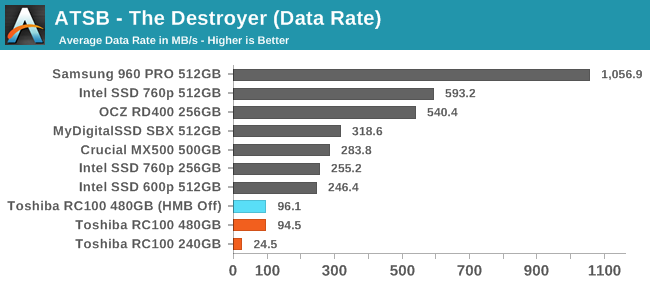
The Destroyer truly lives up to its name when presented with the Toshiba RC100. High-end NVMe SSDs complete this test in as little as seven hours. Mainstream SSDs usually take more like twelve hours. The 240GB Toshiba RC100 took 34 hours, leaving us with insufficient time to run the test again with HMB off. The Host Memory Buffer doesn't even come close making an impact on how long the larger 480GB model took, because The Destroyer simply moves too much data for a small cache to matter.
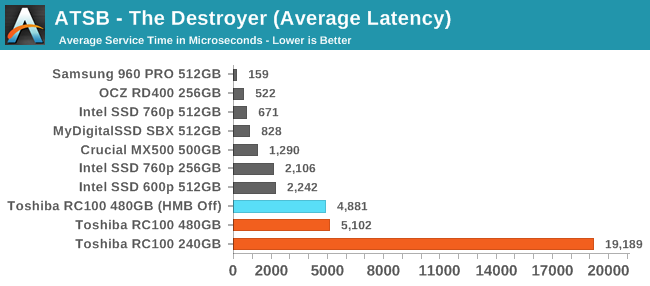
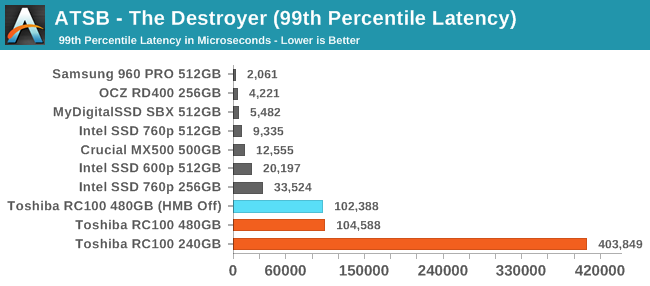
The average latency from the 480GB RC100 on The Destroyer is at least twice as high as that of other low-end NVMe SSDs, and the 240GB's latency is an order of magnitude worse. The situation for 99th percentile latency is even worse, leaving the RC100 looking bad even in comparison to most SATA SSDs.
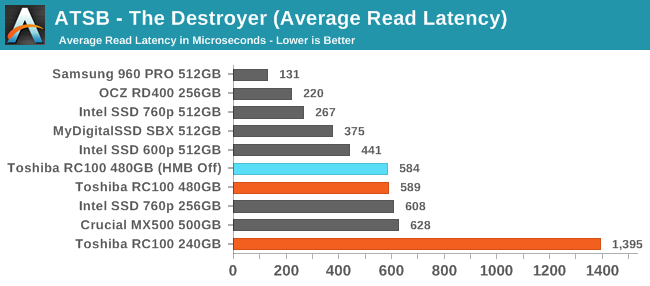
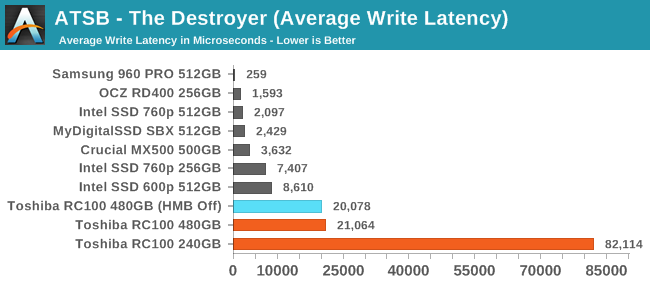
The average read latency of the 480GB RC100 is a bit high but still within the normal range for most SSDs, but the 240GB stands out with more than twice the read latency. For writes, both capacities of the RC100 score poorly, and this is why the overall average tanked.


In spite of its DRAMless design, the 480GB RC100 manages a decent 99th percentile read latency score, but its smaller sibling can't control read latency under a workload this heavy. For writes, both capacities have very high 99th percentile latency, with the 240GB approaching a full second for its worst-case completion times.

The Toshiba RC100 uses relatively little power, but its poor performance means that the test runs long enough that total energy usage isn't great. The 240GB RC100's run of The Destroyer went on for longer than any other SSD tested in recent memory, leaving it with an energy usage score that looks more like what a desktop hard drive would produce.










62 Comments
View All Comments
XabanakFanatik - Thursday, June 14, 2018 - link
Seriously? We get this instead of the 970 Pro or 905p review? Did anyone actually care about this drive?Billy Tallis - Thursday, June 14, 2018 - link
Personally, I find doing a review like this to be a lot more interesting than testing an overpriced flagship product where I know going into it that the conclusion will be that a drive 1/2 or 2/3 the price is just as good for realistic use cases. It's interesting to explore the current state of the art for high-end tech, but it's more interesting to explore new tech in the context of something that might also be a sane purchase.XabanakFanatik - Thursday, June 14, 2018 - link
I'm not sure how interest explains why you've reviewed this two days after it shipped but 7 weeks after you posted the 970 Evo review, there is no 970 pro review. Every other inferior review website posted the pro and evo reviews simultaneously, so Samsung must have sent you both drives around the same time.And Seriously, this is more interesting than reviewing the first optane refresh 905p?
close - Thursday, June 14, 2018 - link
They're usually very late with most reviews. Except Intel ones.Ostensibly because they want to provide the best information out there.
Samus - Thursday, June 14, 2018 - link
Need a review of a 970 Pro? Read the 970 Evo review and assume it’s moar better for proportionately moar money.bananaforscale - Monday, July 9, 2018 - link
Not proportionately. Flagship products *never* have a price that's proportional to performance.artifex - Thursday, June 14, 2018 - link
You already know a bazillion other sources for a 970 Evo review, so you're beating this guy up for being different? He says doing this review is more interesting for him, so no wonder he did it.Also, since you're calling Anandtech an inferior review site, he's hardly likely to change just for you, now.
XabanakFanatik - Thursday, June 14, 2018 - link
I was saying every other review site was inferior, yet they posted 970 PRO reviews the same time as 970 EVO reviews. My issue with Anandtech was the sole posting of the 970 EVO review and no 970 PRO review now for over 7 weeks.Nobody tests like Anandtech. I'm sad that the halo drives aren't a priority for Billy, since the market for them is actually really big.
lmcd - Thursday, June 14, 2018 - link
Most people I know look at the 970 EVO as the highest price drive they'll consider. I almost didn't even consider it.XabanakFanatik - Thursday, June 14, 2018 - link
I can think of a half dozen people I know that would have never considered the 900 Pro drive at the previous price point that bought one after Samsung's mysterious price drop at launch of the 970 series. Lopping off 20-25% of MSRP tends to work pretty well to sell a new generation that was previously priced too high.